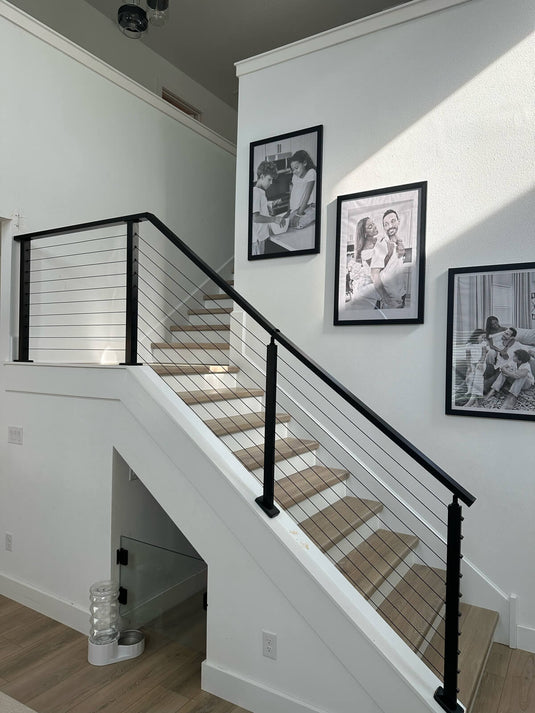TABLE OF CONTENTS
Do Cable Railings Sag Over Time and How to Fix It?

Cable railings have become popular in modern home design, prized for their sleek lines and unobstructed views. However, homeowners often ask if these elegant features stand the test of time without sagging. In this article, we'll talk about the longevity of cable railings, explain why they might lose tension, and provide you with practical solutions to keep them as taut and sturdy as the day they were installed. If you're considering installing cable railings or seeking ways to maintain an existing system, our guide will help your railings continue to combine form with function beautifully and safely.
An Overview of Cable Railing Systems
Function and Advantages
The primary function of cable railings is to provide safety by preventing falls from elevated areas such as decks, balconies, and staircases. Beyond this essential role, they offer significant advantages:
- Aesthetic Appeal: Cable railings have a minimalist design that complements various architectural styles, from modern to rustic.
- Durability: Made from robust materials like stainless steel, these railings resist corrosion and wear, making them suitable for both indoor and outdoor use.
- Low Maintenance: Unlike wood or iron alternatives that may require frequent painting or treatment, cable railings need relatively minimal upkeep to retain their appearance and structural integrity.
Performance Over Time

Properly installed and tensioned cable railings are designed to stand firm against the test of time. However, like any part of a home, they may require adjustments and maintenance. The key to longevity lies in the initial installation quality, the materials chosen, and ongoing care. With appropriate attention, cable railings can remain functional and visually appealing for decades, continuing to offer an unobstructed view while ensuring safety and compliance with building codes.
Why Do Cable Railings Sag?
Natural Causes
The environment plays a significant role in the maintenance of cable railings:
- Weather Effects: Exposure to varying temperatures can cause the metal cables to expand and contract, which may result in a loss of tension over time.
- Material Expansion/Contraction: Different materials react differently to temperature changes. Stainless steel, for example, will have a different rate of expansion or contraction compared to aluminum, which may affect the overall tension within the system.
Physical Stressors
Usage and external forces also contribute to potential sagging:
- Weight Loads: Heavy, consistent loads applied directly to the cables can stretch them out more quickly than typical, everyday use would.
- Consistent Pressure Points: Leaning or applying pressure regularly at the same points on the cable railing can create areas of weakened tension.
Wear and Tear
The inevitable process of aging affects all materials:
- Time-related Loosening: Over years of use, fittings and anchors can become loose due to the constant tension and release cycle, leading to reduced cable tautness.
- Friction: The rubbing of cables against posts during movement can wear down the cable and reduce its diameter, causing slack.
Signs and Symptoms of Cable Railing Sag
Detecting early signs of sagging in your cable railing can prevent minor issues from becoming major problems. There are several indicators that you can look out for:
- Visible Slackness: The most apparent sign of sagging is visible droopiness in the cables. When the railings are correctly tensioned, they should appear straight and taut. Any noticeable bowing or slackness is a clear signal that the cables need re-tensioning.
- Unusual Sounds or Movement: Cable railings should be relatively quiet and only exhibit minimal movement when force is applied. If you start to hear creaking sounds or notice excessive swaying or movement when the cables are touched or during windy conditions, it's likely that the system's tension has been compromised.
- Measuring Tension: Using a cable tension gauge can provide a quantitative assessment of whether the cables have lost tension. Measurements that fall below the manufacturer's recommended tension levels indicate that adjustments are necessary to restore the cable railing's safety and performance.
Preventative Measures for Maintaining Cable Railing Tension

Preventative maintenance is the cornerstone of ensuring that your cable railings remain both visually pleasing and structurally sound. A proactive approach to care can help prevent sagging and extend the lifespan of your railing system.
Regular Inspections
- Visual Checks: Perform visual assessments of cable tension and look for signs of wear or corrosion on cables and fittings.
- Physical Tests: Gently applying pressure to the cables can help determine if they have an unusual amount of give or movement.
Cleaning and Maintenance
- Corrosion Prevention: Regularly clean the cables, especially in harsh environments like coastal areas where salt spray is common, to prevent rust and deterioration that could weaken the cables.
- Lubrication: Apply an appropriate lubricant to fittings and tensioners to keep them functioning correctly and protect against seizing that can impede proper tensioning.
Professional Installation
- Expertise: Engaging professionals for the installation ensures that your cable railing system is set up correctly from the beginning, with optimal tension and secure fittings.
- Compliance: Professionals are familiar with local building codes and regulations, which helps in installing a compliant and safe cable railing system.
Step-by-Step Guide to Fixing Sagging Cable Railings
Assessing the Extent of Sag
- Visual Inspection: Look along each cable line for noticeable drooping.
- Measure Tension: Use a tension gauge to check whether the cables are at the manufacturer’s recommended tension levels.
- Check Fittings: Examine all fittings and hardware for signs of wear or damage that could contribute to sagging.
Tightening Procedures
Once you've assessed the cables, proceed with the following tightening procedure:
- Loosen Fittings: Start by slightly loosening the fittings to prepare the cables for re-tensioning.
- Tighten Cables: Gradually tighten each cable, working from one end of the railing to the other. Make sure you tension the cables evenly to maintain a level railing line.
- Re-check Tension: After tightening, use the tension gauge again to ensure all cables meet the recommended tension specifications.
- Secure Fittings: Once proper tension is achieved, secure all fittings and let them locked in place.
The Enduring Value of Maintained Cable Railings
In closing, cable railings are a preferred choice for adding elegance and open views to your property while ensuring safety and compliance with architectural standards. However, like any other aspect of a home, they require a certain level of care and attention to maintain their integrity over time. Sagging is a common issue that can arise, but with the right knowledge and approach, it's a manageable one.
The journey through this article has equipped you with an understanding of what causes cable railings to sag, how to identify the early signs, and the steps you can take to remedy it. We've outlined preventative measures that focus on regular inspections and proper maintenance. Maintained with diligence, cable railings not only continue to perform their essential function but also retain their beauty over many years. They are an investment in the aesthetic and functional quality of your home.




